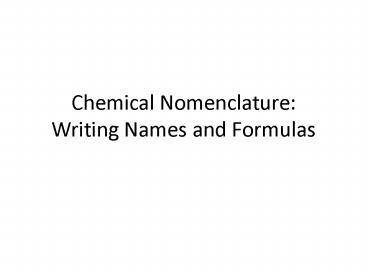Chemical Nomenclature: Writing Names and Formulas - PowerPoint PPT Presentation
Title:
Chemical Nomenclature: Writing Names and Formulas
Description:
Chemical Nomenclature: Writing Names and Formulas Bonding is the way atoms are attracted to each other to form compounds. During bonding atoms gain, lose, or share ... – PowerPoint PPT presentation
Number of Views:375
Avg rating:3.0/5.0
Title: Chemical Nomenclature: Writing Names and Formulas
1
Chemical Nomenclature Writing Names and
Formulas
2
Bonding is the way atoms are attracted to each
other to form compounds. During bonding atoms
gain, lose, or share electrons to reach stable
configurations. The three types of compounds
which you should be able to recognize
are -Ionic Compounds -Covalent (Molecular)
Compounds -Acids
3
Nonmetals
Metals
4
Ionic Compound Metal Nonmetal
Metal atoms will give up electrons to form
positive ions (cations) and non-metal atoms will
receive or take additional electrons to become
negative ions (anions). The bond forms when
there is this transfer of electrons from metal to
nonmetal. The molecule is held together by
opposite charges attracting (electrostatic
attraction)
5
Sodium Chloride is an Ionic Compound
6
Covalent (Molecular) CompoundNonmetal Nonmetal
- Nonmetals hold onto their valence electrons.
- They cant give away electrons to bond, so
instead they share electrons. - Water is a molecular compound
7
Acids Hydrogen Nonmetal or Hydrogen
Polyatomic Ion
- An acid is a compound consisting of hydrogen
combined with a non-metallic element or with a
polyatomic ion - Ex. HCl or H2CO3
- In the formula for an acid, hydrogen is always
listed as the first element. - (The only exception to this is water, H2O)
- Note If you continue with your study of
chemistry you will learn that there are other
ways to define acids. For our purposes, it will
be convenient to identify an acid as something
which can release H in water.
8
Names and Formulas for Ionic Compounds
9
- Common Ion Charges
Varies will either be given to you or you can
work backwards from the formula to determine the
charge. Memorize Zn2, Ag, and Cd 2
1
0
2
3
4
3-
2-
1-
10
Simple Ionic Compounds
The overall charge of ionic compounds must equal
zero. When you write formulas use the swap and
drop method to balance charges. (You should
simplify subscripts if possible.)
11
Ionic Compounds Containing Polyatomic Ions
A polyatomic ion is a group of atoms that has a
charge. It is treated like a single ion in
formulas, but must have parentheses when more
than one is used.
12
Naming Ionic Compounds
Write the names of both ions, cation first.
Change ending of anion to -ide. Polyatomic ions
have special endings. Stock System- Use Roman
numerals to show the cations charge if more than
one is possible. (There is also an older naming
system using Latin roots and an ous or ic
ending)
13
What is the name of the compound formed when zinc
combines with fluorine?
- zinc difluoride
- zinc fluorate
- zinc fluoride
- zinc (II) fluorite
14
The correct formula for aluminum oxide is
- Al3O2
- Al2O2
- Al2O3
- Al4O3
15
Name the compound Ni(ClO3)2
- nickel chlorate
- nickel chloride
- nickel chlorite
- nickel (II) chlorate
16
What is the formula for tin (IV) chromate?
- Sn(CrO4)4
- Sn2(CrO4)2
- Sn2(CrO4)4
- Sn(CrO4)2
17
Names and Formulas for Covalent (Molecular)
Compounds
18
To Name A Binary Non-MetalCompound
- Name each element in the order they appear in the
formula - Use the appropriate prefix to indicate the number
of atoms of the element in the compound. - The second element uses an ide ending.
- The prefix mono- is generally omitted on the
first element.
19
Prefixes
- Hexa- 6
- Hepta- 7
- Octa- 8
- Nona- 9
- Deca- 10
- Mono-1
- Di- 2
- Tri- 3
- Tetra- 4
- Pent/Penta- 5
20
To Write Formulas for a Binary Non-MetalCompound
- Put the elements in the same order that they
appear in the name - Use the prefixes to determine the number of each
element in the formula. - DO NOT simplify subscripts.
- DO NOT swap and drop.
21
Names and Formulas for Acids
22
Binary or Non-Oxygen Acids
- Binary acids consist of hydrogen combined with a
non-metal element. - Binary acids are named by using the prefix hydro-
followed by the stem name of the non-metal
element (the second element in the formula) with
an ic ending. - The name is followed by the word ACID.
23
Examples
- HCl is named hydrochloric acid
- HBr is named hydrobromic acid
- HI is named hydroiodic acid
- H2S is named hydrosulfuric acid
- (Notice that charges must still balance so you
must still do swap and drop when writing
formulas)
24
Acids Containing Polyatomic Ions
- These acids contain three elements hydrogen, a
non-metal, and oxygen. (ie hydrogen and a
polyatomic ion) - Look at the polyatomic ion you are using to
choose the ending for the name - Polyatomic ion ending in ite -ous ending
- Polyatomic ion ending in ate -ic ending
- DO NOT use the prefix Hydro-
25
Examples
- H2SO3 is named sulfurous acid
- H2SO4 is named sulfuric acid
- (Notice that charges must still balance so you
must still do swap and drop when writing
formulas)































